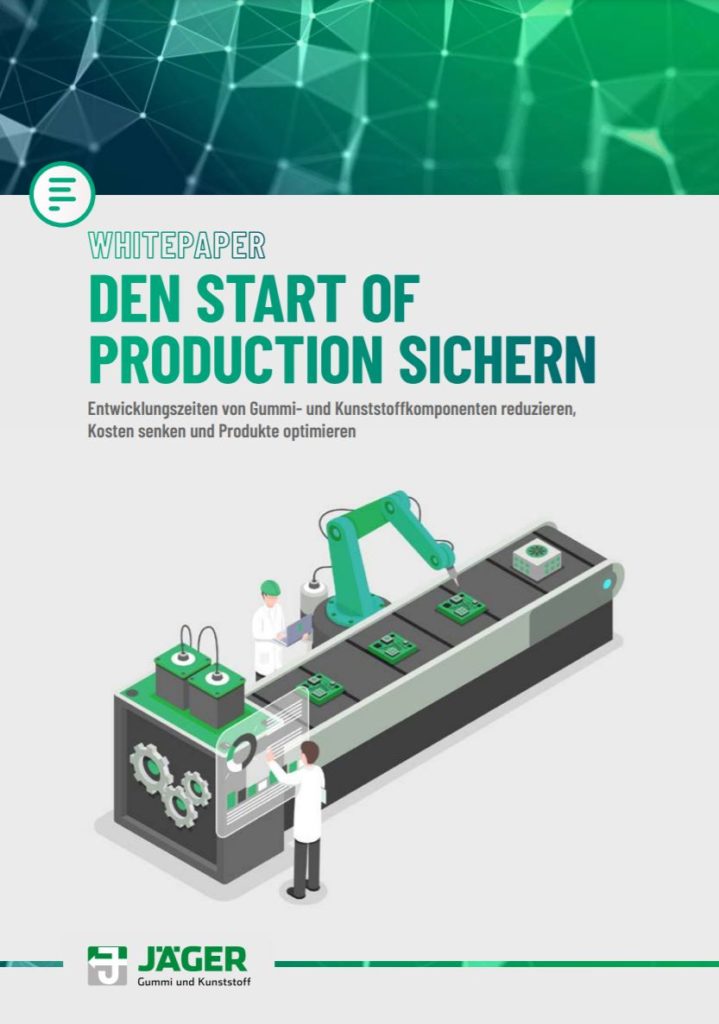
JÄGER Business Blog


WHITEPAPER
Find out which factors influence your SOP!
Since the Corona pandemic drove employees around the world into home offices, remote work has become the new standard in the working world. In many companies, it is now even unusual to meet people outside of one’s own organization in face-to-face meetings. As a result, customer or supplier meetings often only take place by telephone or via web meetings. However, this approach is only optimal to a limited extent. Especially in the rubber and plastics industry, a personal meeting on site is often the better alternative.
Online meetings offer a lot of advantages, especially in the current pandemic situation. They’re flexible, cost-effective, easy to set up, and easy on the environment. It makes sense that many companies have digitized most of their communication processes. However, virtual meetings are not suitable for all situations. There are still good reasons to meet with business partners on site and discuss important issues face-to-face.
If we look at the rubber and plastics industry, there are three perspectives that speak for face-to-face communication on site: the customer’s perspective, the supplier’s perspective and the social level.
Elastomers and plastics are materials that require a great deal of consultation, depending on the application. Although there are standard products on the market, it is often necessary to find suitable customer- and application-specific solutions that are precisely tailored to the respective area of application. For this reason, development projects in the rubber and plastics sector are communication-intensive. Depending on the complexity of the project, the customer and supplier should jointly define the framework conditions and the individual project steps in advance, way before the first series delivery can take place.
This intensive exchange of information is difficult to implement in virtual meetings. Rubber and plastic components are often abstract and very specific. Describing them in an online meeting in a way that other people can imagine is a challenge. Especially since the information must be presented very precisely so that the design department can, for example, use it to create an initial design drawing for a new development. Describing the use case and the desired function of a “seal” purely by phone, for example, without a visual component, is rather cumbersome.
Pictures and videos of the application environment or the machine in which the component is to be installed can help. However, it is not guaranteed that the design department will be able to do anything with these shots. It often needs views from different angles or a close-up of a particular area. It may be able to pass through instructions on how the images should look. But explaining to someone in a video call what details should be photographed is usually inefficient.
Most of these difficulties can be avoided if the rubber or plastics producer’s contact persons are on site in person. All the customer has to do is guide the supplier visit through his company’s production to the component’s installation situation, where he can point out important influencing factors. The practical context of the interaction – standing in front of the machine – makes it easier for the customer’s team to describe their goals and requirements accurately and completely.
This procedure makes it easier for the supplier to shape the project too, as he can get a picture of the application area directly on site. Questions can be asked directly at the machine. In some cases, a completely different solution may be found than initially thought in the preliminary discussion. Or an alternative material for an existing component may be considered that is more robust and less expensive.
In the course of the visit, the supplier’s technical experts may also notice further optimization opportunities and saving-potentials during the tour of the customer’s production facility, resulting in additional joint projects. Most customers are happy to incorporate these tips and new ideas if they can add potential value.
From the supplier’s point of view, an on-site visit focuses on content that relates to the feasibility of the targets. This includes the following questions:
Such aspects are often not considered or underestimated by the customer’s contact persons. If necessary, they can even jeopardize the implementation of the entire project.
In addition, there are factors that cannot be conveyed via an audio-visual communication channel, such as haptics. For the design, it can be helpful to know how a component to be replaced or its operational environment feels. What is the surface texture of the previously used material? How elastic is the material? Is the component firmly seated in the installation situation or does it have a clear space? Does it heat up during operation or does it stay cool? These and other factors are not always mentioned in discussions, but they can have an influence on the further implementation of the project.

Technical consultation on site
Although the focus of a development project for rubber or plastic components is on rational aspects, the social level should also be taken into account. The interpersonal aspect can have a serious influence on the course of the project. Poor relations between the employees of both companies lead to conflicts.
It even happens that social components tip the scales in favor of a particular provider when looking for a new development partner. For example, when both teams know each other well and have already worked together. Trust is sometimes weighted higher than technical or commercial aspects
Video conferencing does allow the leaders of both companies to get to know each other, but these impressions are not comparable to those conveyed by a face-to-face meeting. Visual and auditory factors are an important part of human communication, but do not make it complete. Non-verbal communication simply falls short. Face-to-face gives us a better impression of a person than video calls, and it’s easier to build mutual trust.
In addition, on-site visits give employees from both companies the opportunity to interact with each other away from formalities, for example during a tour or over lunch. A purely virtual exchange, on the other hand, offers little scope for further discussion.
Face-to-face meetings between customer and supplier mainly take place at the beginning of the project. As the project progresses, contact usually shifts to the digital realm, since no new information needs to be recorded.
Towards the end of the project, however, on-site meetings become relevant again. Have all the technical and commercial details been clarified, or are there still reservations? This is where face-to-face meetings come in handy to reach a final agreement on larger projects. But an on-site visit also makes sense in the event of a service or complaint. If a component is defective, the customer contacts the supplier’s field service, which can rectify or clarify the problem on site. This interaction is also possible via digital channels, for example by e-mail with attached photos. However, personal contact offers advantages that should not be ignored.
Based on text and pictures, the delivery partner can assess what the damage is, but not necessarily why it occurred. As a rule, the defective component is simply replaced without remedying the cause of the damage. The consequence is that the replacement part may also fail in the foreseeable future. However, if someone is on site to assess the situation and identify the underlying problem, the supplier may be able to find a solution and prevent damage from occurring again.
Hybrid models are particularly useful in the service area. Here, a specialist is on site to inspect the defective part and analyze the cause of the damage. If necessary, experts are called in by video conference (for example, via smartphone) to assist with technology and troubleshooting. This approach offers maximum flexibility.

Whitepaper: Secure the Start of Production
Learn which factors influence your SOP!
Even in the digital age, face-to-face meetings still have their raison d’être. In rubber and plastics development projects, they allow stakeholders to look at the product’s field of application, fully understand the use case, examine samples, ask for contextual information, provide feedback, and assess the interpersonal. All of these aspects are invaluable to any development project.
Not everything can be settled by mail or digitally. That is why it will continue to be worthwhile to meet business partners on site and hold personal discussions. Because only when the supplier knows the customer and his products exactly customized manufacturing solutions can be offered that cover all requirements.
Rainer Brügma has been working for Jäger for more than 20 years, including more than 15 years in field service. With his many years of experience in the rubber and plastics sectors, the trained forwarding merchant supports our customers in the greater Oldenburg/Bremen area.
Share post now!
Jäger Gummi und Kunststoff GmbH
Lohweg 1
30559 Hannover
Tel. +49 511 – 53580
Fax +49 511 – 553394
info@jaeger-gk.de
Management:
Dipl.-Ing Sebastian Jäger
Julius Jäger, M.Sc.
Hanover Register Court HRB 59798
DE 813 314 161

Petra Dirlenbach